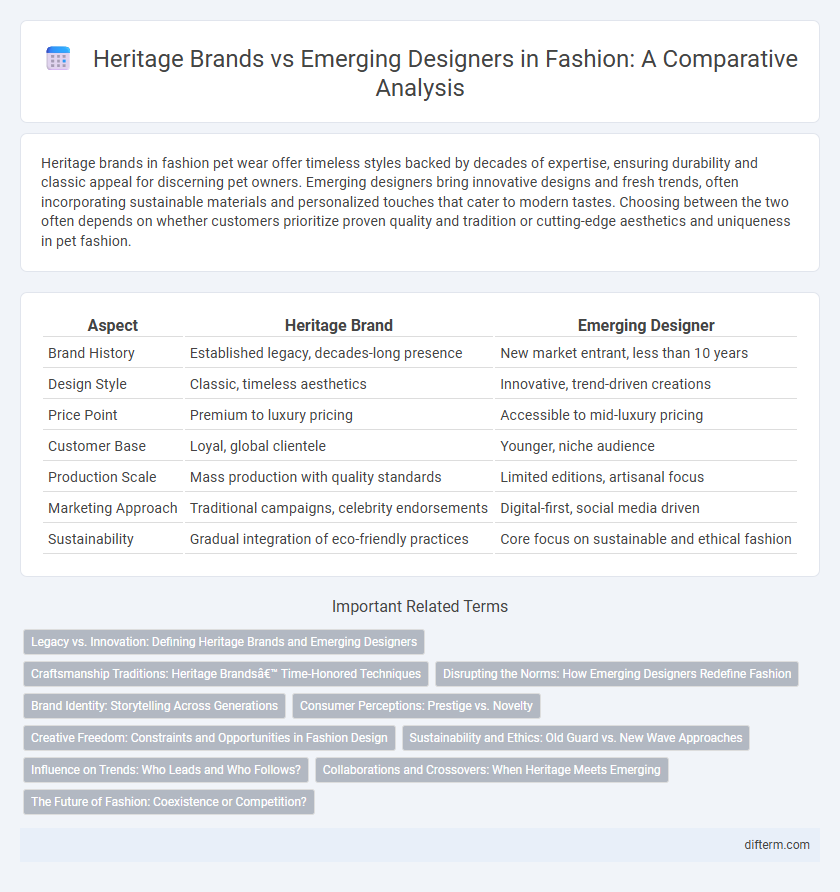Heritage brands in fashion pet wear offer timeless styles backed by decades of expertise, ensuring durability and classic appeal for discerning pet owners. Emerging designers bring innovative designs and fresh trends, often incorporating sustainable materials and personalized touches that cater to modern tastes. Choosing between the two often depends on whether customers prioritize proven quality and tradition or cutting-edge aesthetics and uniqueness in pet fashion.
Table of Comparison
| Aspect | Heritage Brand | Emerging Designer |
|---|---|---|
| Brand History | Established legacy, decades-long presence | New market entrant, less than 10 years |
| Design Style | Classic, timeless aesthetics | Innovative, trend-driven creations |
| Price Point | Premium to luxury pricing | Accessible to mid-luxury pricing |
| Customer Base | Loyal, global clientele | Younger, niche audience |
| Production Scale | Mass production with quality standards | Limited editions, artisanal focus |
| Marketing Approach | Traditional campaigns, celebrity endorsements | Digital-first, social media driven |
| Sustainability | Gradual integration of eco-friendly practices | Core focus on sustainable and ethical fashion |
Legacy vs. Innovation: Defining Heritage Brands and Emerging Designers
Heritage brands embody decades of craftsmanship, established identities, and timeless appeal rooted in tradition and cultural significance. Emerging designers prioritize innovation, experimenting with new materials, cutting-edge techniques, and bold aesthetics to disrupt fashion norms. The dynamic tension between heritage brands' legacy and emerging designers' innovation drives the evolution of the fashion industry, balancing preservation with contemporary creativity.
Craftsmanship Traditions: Heritage Brands’ Time-Honored Techniques
Heritage brands preserve craftsmanship traditions through meticulous hand-stitching, artisanal embroidery, and time-honored tailoring techniques that have been refined over decades. These brands often source rare, high-quality materials and maintain a workshop environment where experienced artisans pass down skills across generations. In contrast, emerging designers may prioritize innovation and experimental methods but frequently lack the deep-rooted expertise and historical continuity embodied by heritage fashion houses.
Disrupting the Norms: How Emerging Designers Redefine Fashion
Emerging designers disrupt the fashion industry by challenging traditional aesthetics and introducing innovative materials and sustainable practices that heritage brands often overlook. Their avant-garde collections resonate with a younger, socially-conscious demographic seeking authenticity and originality in apparel. This shift drives the evolution of style paradigms, compelling legacy brands to adapt and reimagine their creative boundaries.
Brand Identity: Storytelling Across Generations
Heritage brands leverage decades, sometimes centuries, of rich history to craft compelling narratives that resonate with established customer loyalty and timeless craftsmanship. Emerging designers inject fresh perspectives into fashion storytelling, often highlighting innovation, cultural shifts, and contemporary values to connect with younger, trend-conscious audiences. Both utilize brand identity to forge emotional connections, but heritage brands emphasize legacy authenticity, whereas emerging designers prioritize dynamic, evolving stories.
Consumer Perceptions: Prestige vs. Novelty
Heritage brands are often perceived as symbols of prestige due to their longstanding tradition, quality craftsmanship, and established reputation, which instills trust and loyalty among consumers. Emerging designers attract consumers seeking novelty and innovation, offering fresh perspectives, unique aesthetics, and contemporary relevance that appeal to trendsetters and early adopters. Consumer perceptions balance the reliability and legacy of heritage brands with the excitement and originality presented by emerging designers, shaping purchasing decisions in the evolving fashion landscape.
Creative Freedom: Constraints and Opportunities in Fashion Design
Heritage brands offer established identity and legacy, often imposing constraints through traditional aesthetics and market expectations, limiting creative freedom for designers. Emerging designers benefit from fewer limitations, fostering innovation and experimentation with new materials, silhouettes, and narratives. Balancing commercial viability with artistic expression remains a challenge for both, shaping the evolution of fashion design.
Sustainability and Ethics: Old Guard vs. New Wave Approaches
Heritage brands often emphasize time-tested sustainability practices grounded in legacy craftsmanship and long-term supplier relationships, ensuring ethical labor standards through established protocols. Emerging designers prioritize innovative eco-friendly materials and transparent supply chains, pushing boundaries with cutting-edge sustainable technologies and ethical sourcing. Both approaches strive to reduce fashion's environmental impact, reflecting a crucial shift toward responsible production in the industry.
Influence on Trends: Who Leads and Who Follows?
Heritage brands often set enduring fashion standards through their rich history and established reputation, influencing trends with timeless designs and classic craftsmanship. Emerging designers drive innovation by introducing bold, avant-garde concepts that challenge conventional aesthetics and capture niche markets quickly. The interplay between heritage brands and emerging designers creates a dynamic fashion ecosystem where tradition informs new trends, and fresh creativity invigorates established styles.
Collaborations and Crossovers: When Heritage Meets Emerging
Collaborations between heritage brands and emerging designers create unique synergies that blend traditional craftsmanship with fresh, innovative perspectives, enhancing both legacy and contemporary appeal. These crossovers often lead to limited-edition collections that leverage the heritage brand's established reputation while introducing experimental designs from new talent. Such partnerships drive consumer interest by combining authenticity, exclusivity, and cutting-edge creativity in fashion.
The Future of Fashion: Coexistence or Competition?
Heritage brands leverage decades of craftsmanship and established customer loyalty, providing a stable foundation in the ever-evolving fashion landscape. Emerging designers push boundaries with innovative designs and sustainable practices, attracting younger, eco-conscious consumers. The future of fashion likely involves coexistence, where heritage brands adopt fresh perspectives and emerging designers gain market presence through collaboration and adaptation.
heritage brand vs emerging designer Infographic

 difterm.com
difterm.com